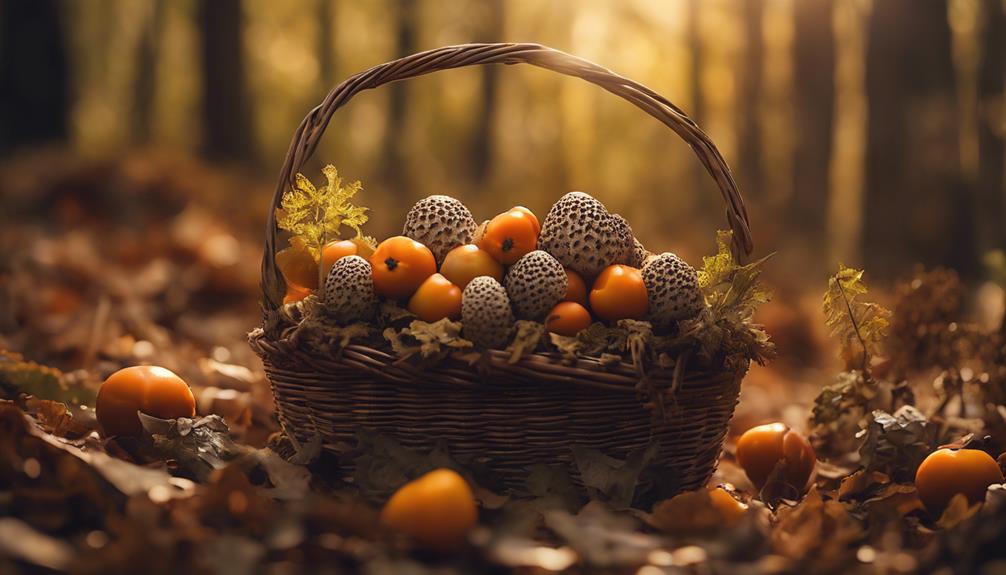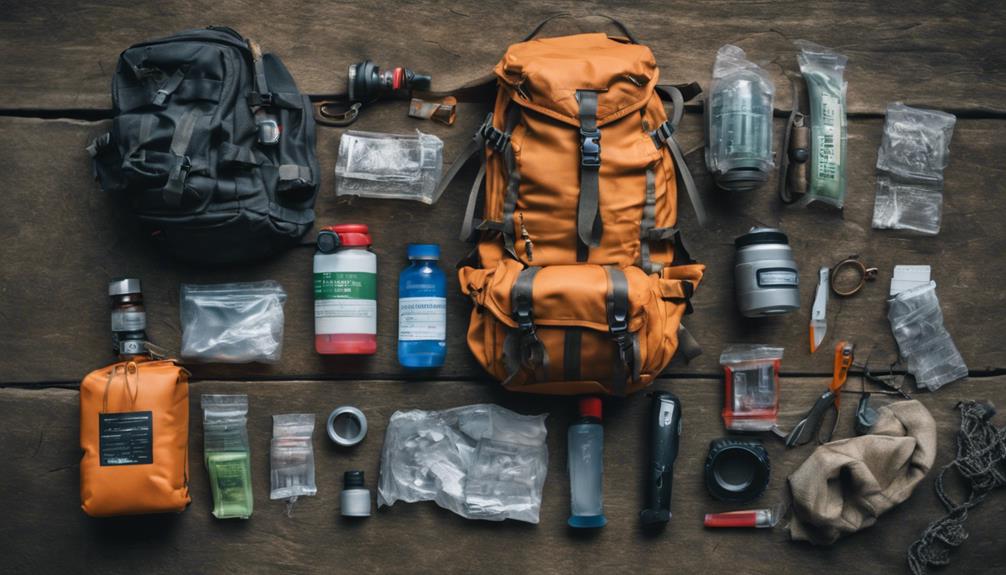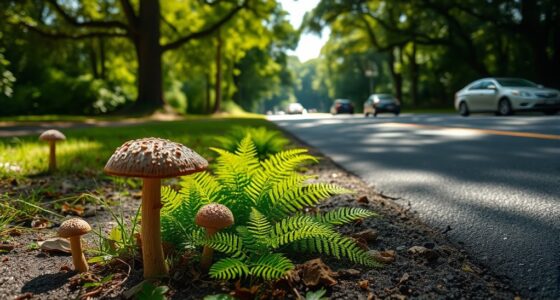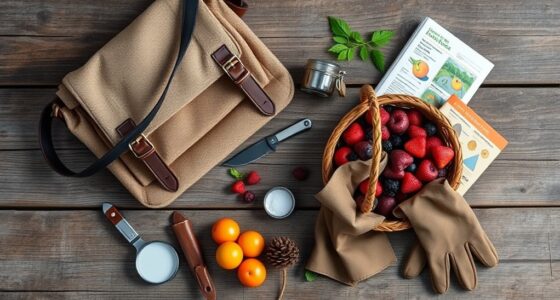As you explore Oklahoma's diverse landscapes, you'll discover a wealth of wild edibles waiting to be foraged. From nutrient-rich native plants like sand plum and pawpaw to prized mushrooms and flavorful herbs, the Sooner State has plenty to offer. Learn about Oklahoma's native edible plants, diverse habitats, and foraging fundamentals to get started. With proper identification and responsible foraging practices, you can uncover the rich flavors and textures of Oklahoma's wild foods. Continue to uncover the secrets of Oklahoma's wild edibles and learn how to incorporate them into your diet for a more sustainable and flavorful lifestyle.
Key Takeaways
- Oklahoma is home to nutrient-rich native edible plants like sand plum, pawpaw, and wild onion, offering vitamins, antioxidants, and unique flavors.
- Foraging in Oklahoma's diverse habitats, including temperate forests, grasslands, and woodlands, connects individuals with the land and preserves cultural heritage.
- Accurate plant identification is crucial for safe foraging, involving recognition of habitats, growth patterns, and lookalike toxic species.
- Oklahoma's wild edibles, such as dandelion greens and wild garlic, introduce novel textures, aromas, and flavors, while offering health benefits and nutritional value.
- Incorporating wild edibles into home gardening practices supports ecological sustainability, local adaptation, and biodiversity, ensuring resources for future generations.
Native Edible Plants in Oklahoma
As you explore Oklahoma's vast landscapes, you'll discover a treasure trove of native edible plants waiting to be foraged, including the nutrient-rich sand plum, pawpaw, and wild onion.
Foraging in Oklahoma is an exciting adventure that awaits you, and these plants are just the beginning. The sand plum, for instance, is packed with vitamins and antioxidants, making it a nutritious addition to your meals.
Pawpaw, on the other hand, is a sweet and creamy fruit that's perfect for snacking or baking. And don't forget about the wild onion, a staple ingredient in Oklahoma cuisine that adds a unique flavor to dishes.
These plants aren't only delicious but also rich in history and cultural significance. By incorporating them into your diet, you'll be supporting local ecological practices and preserving Oklahoma's culinary heritage.
Oklahoma's Diverse Habitats

Frequently, you'll find that Oklahoma's diverse habitats, ranging from temperate forests to central grasslands, support a wide variety of plant and wildlife species that are essential to foraging and appreciating the rich biodiversity of native edible plants.
As you explore Oklahoma's diverse habitats, you'll discover that understanding the unique ecosystems is vital for foraging and appreciating the rich biodiversity of native edible plants. You'll find that the state's varied landscapes shape the availability of wild foods, showcasing the importance of native plants in different regions of Oklahoma.
- Oklahoma's temperate forests offer a haven for wild edibles like mushrooms and wild berries.
- The central grasslands provide an abundance of native plants like buffalo gourd and prairie clover.
- Woodlands and prairies support a rich tapestry of wild foods waiting to be discovered and enjoyed.
- Foraging in Oklahoma connects individuals with the land, fostering environmental appreciation and cultural significance tied to the diverse habitats.
- By embracing Oklahoma's diverse habitats, you'll uncover the rich cultural heritage and environmental significance tied to the state's native plants.
Foraging Fundamentals

Prior to starting a search for Oklahoma's wild edibles, mastering the fundamentals is essential. This includes accurate plant identification, taste testing, and consideration of potential allergies.
You'll want to develop essential plant identification skills to guarantee safe foraging of native edible plants in Oklahoma. This involves more than just recognizing the plant's appearance; you should also know its habitats, growth patterns, and any lookalike species that might be toxic.
When testing a new plant, start by rubbing a small portion on the inside of your wrist to check for any adverse reactions. Remember to always prioritize responsible foraging practices, leaving sufficient resources for future generations and obtaining permission before foraging on private land.
Notable Edible Plants

As you explore Oklahoma's wild foods, you'll discover a variety of notable edible plants that will elevate your culinary game.
From the sweet and tangy flavors of sand plum and pawpaw to the pungent kick of wild onions, these native species offer a world of flavors waiting to be uncovered.
Get ready to uncover the prairie's hidden gems and discover the tasty weeds that'll take your cooking to the next level.
Wild Edibles to Try
In Oklahoma's wild, you'll find a trio of native edible plants – sand plum, Pawpaw, and wild onion – that boast exceptional nutritional value and culinary versatility. These plants aren't only delicious but also packed with nutrients, making them a great addition to your meals.
As you explore Oklahoma's wild, you'll discover a variety of edible plants that can elevate your cooking. Here are some wild edibles to try:
Sand plum: Rich in antioxidants** and fiber, sand plum makes a great jam or sauce.
** Pawpaw: With its unique flavor and high nutritional value, pawpaw is perfect for smoothies or baked goods.
** Wild onion: Add a punch of flavor to your dishes with wild onion, rich in vitamins and minerals.
** Prickly pear: This versatile plant offers both culinary and landscaping benefits, making it a great addition to your garden.
Incorporate wild edibles into your home gardening practices to support ecological sustainability and local adaptation** to the Oklahoma environment.
Remember to identify plants correctly before consumption and enjoy the culinary treasures Oklahoma's wild has to offer!
Prairie Delicacies Uncovered
Your foraging adventure in Oklahoma's prairies uncovers a treasure trove of edible delights, each with its unique flavor profile and nutritional benefits. As you explore the prairies, you'll discover an array of native species waiting to be savored.
Sand plum and Pawpaw, for instance, offer a flavor experience like no other. The sand plum's sweet and tangy taste is perfect for jams and preserves, while the Pawpaw's creamy flavor makes it an excellent addition to smoothies and baked goods.
When foraging, keep an eye out for wild onions, a staple ingredient in Oklahoma cuisine. Rich in flavor, they're commonly used in traditional dishes and add a burst of flavor to any meal.
And don't forget about the prickly pear, a common plant in Oklahoma that provides edible fruits and pads. Its southwestern flair is perfect for adding a twist to your favorite recipes. By incorporating these native edible plants into your foraging adventure, you'll not only indulge in delicious flavors but also support local ecosystems and promote sustainability.
Tasty Weeds Abound
Among Oklahoma's wild landscape, you'll stumble upon an array of tasty weeds, each boasting unique flavors and textures that'll elevate your culinary creations. Foraging for wild edibles is an exciting adventure, and Oklahoma's native plants won't disappoint. Here are some notable edible species to look out for:
- Sand plum: A sweet and tangy fruit perfect for jams, preserves, and desserts.
- Pawpaw: A tropical-tasting fruit with a creamy, custard-like texture.
- Wild onion: A staple ingredient in Oklahoma cuisine, adding depth and flavor to dishes.
- Prickly pear cactus: Providing both edible fruit and aesthetic value in landscaping.
- Native wild edibles: Incorporate these into your home garden to support ecological practices and foster local adaptation to Oklahoma's environment.
When foraging for wild edibles, remember to respect the environment, only harvest what's abundant, and accurately identify the species to make sure a safe and enjoyable culinary experience. Happy foraging!
Plant Identification Tips

You must develop a keen eye for detail to accurately identify wild edibles, as mistaken identity can have serious consequences.
When it comes to foraging for Oklahoma's wild foods, proper plant identification is vital for safe consumption. You'll need to distinguish between edible and non-edible plant species to avoid potential risks.
Start by researching the specific characteristics of the plant species you're interested in foraging. Take note of the plant's shape, size, color, and texture, as well as its growth habits and habitats.
Be cautious when conducting taste tests, and always wait for any adverse reactions before consuming a new plant. It's also essential to test for allergies by rubbing the plant on the inside of your wrist to check for any adverse effects.
Culinary Uses of Wild Edibles

As you explore the culinary uses of wild edibles, you'll discover a world of flavors and possibilities.
From the rich, earthy flavors of wild mushrooms to the bright, fruity notes of foraged herbs, Oklahoma's wild edibles offer a treasure trove of flavors to enhance your cooking.
Let's explore the unique flavor profiles, edible mushroom delights, and herbal tea creations that will take your cooking to the next level.
Wild Flavor Profiles
By incorporating wild edibles into your recipes, you'll discover a world of complex flavor profiles that cultivated foods simply can't match. Wild foods offer unique tastes that will add depth and diversity to your culinary creations.
Here are some examples of the exciting flavor profiles you can explore:
- Dandelion greens and nettles provide a range of flavors from bitter to earthy, enhancing dishes with complexity.
- Wild garlic and purslane bring a burst of freshness and pungency to recipes, elevating the overall taste profile.
- Incorporating wild edibles introduces novel textures and aromas, creating a memorable dining experience.
- Experimenting with indigenous ingredients like wood sorrel and 'poor man's pepper' adds a local and seasonal touch to dishes, reflecting Oklahoma's terroir in culinary creations.
- Wild edibles can also offer a range of health benefits, making them a great addition to your recipes.
Edible Mushroom Delights
Oklahoma's diverse landscapes yield a fascinating array of edible mushrooms, including prized species like morels, chanterelles, and chicken of the woods, waiting to be discovered and showcased in your culinary creations.
As you forage through Oklahoma's wild, you'll uncover a world of flavors and textures to elevate your dishes. Imagine adding earthy morels to a rich risotto or sautéing chicken of the woods with garlic and thyme. The possibilities are endless, and the thrill of the hunt only adds to the excitement.
Herbal Tea Creations
While wandering through Oklahoma's wild landscapes, you'll stumble upon a multitude of wild edibles that can be transformed into flavorful and aromatic herbal teas. As you forage, you'll discover the perfect ingredients to craft unique blends that not only tantalize your taste buds but also provide numerous health benefits.
Here are some wild edibles you can use to create your signature herbal teas:
- Mint: Known for its digestive aid and invigorating flavor, mint is a popular choice for herbal teas.
- Chamomile: This calming wild edible promotes relaxation and soothes the mind and body.
- Elderflower: With its delicate flavor and aroma, elderflower tea is perfect for unwinding after a long day.
- Lemon balm: Add a hint of citrus to your tea with lemon balm, which also supports digestive health.
- Hibiscus: This vibrant flower adds a fruity flavor and a pop of color to your herbal tea blends.
Health Benefits and Nutrition

Discover the nutritional riches of Oklahoma's wild edibles, which pack a punch of essential vitamins and minerals to supercharge your diet. As you forage for these hidden gems, you'll uncover a treasure trove of nutrient-dense foods that will elevate your health and well-being.
Native plants like Amaranth, Pawpaw, and Wild Onion offer significant vitamin and mineral profiles, contributing to a balanced diet.
You'll find that Oklahoma's wild edibles are rich in iron, fiber, vitamins A and C, providing essential nutrients for overall health.
Incorporating Wild Edibles Home

By incorporating wild edibles into your home garden, you'll not only cultivate a nutrient-dense harvest but also support Oklahoma's ecosystem and promote local adaptation. This approach enhances nutritional diversity and supports sustainable practices, making it a win-win for you and the environment.
Here are some ways to incorporate wild edibles into your home garden:
- Grow native species like wild onions, sand plums, and pawpaws for culinary use
- Utilize prickly pears in your landscape for added versatility and culinary benefits
- Understand the importance of native plants in home gardening for ecological health and wildlife support in Oklahoma
- Experiment with different wild edibles to add variety to your diet and reduce reliance on industrial agriculture
- Create a diverse and resilient home garden that supports local biodiversity
Conservation and Ethical Wildcrafting

As you cultivate a deeper connection with Oklahoma's wild edibles, it's equally important to adopt conservation-minded practices that guarantee the long-term sustainability of these natural treasures.
Conservation efforts focus on habitat protection, propagation, and education to preserve native species. By adopting ethical wildcrafting practices, you'll secure sustainable harvesting techniques that consider the long-term impact on plant populations.
Preserving native plant populations is vital for maintaining biodiversity, ecosystem balance, and genetic diversity in Oklahoma.
To forage responsibly, you should practice seed collection, leave enough resources for future generations, and avoid over-harvesting protected species. Education about plant identification and conservation is key to contributing to the preservation of Oklahoma's diverse wild foods.
By adopting these practices, you'll not only secure the long-term availability of Oklahoma's wild edibles but also preserve the state's natural heritage.
Oklahoma's Wild Food Scene

As you explore Oklahoma's wild food scene, you'll discover a treasure trove of native edibles waiting to be uncovered.
From wild harvesting hotspots to seasonal foraging guides, you'll find a wealth of resources to help you make the most of the state's natural bounty.
Whether you're a seasoned forager or just starting out, Oklahoma's wild food scene has something to offer, and it's time to start exploring!
Native Edibles Abound
Exploring Oklahoma's wild food scene reveals a treasure trove of native edibles, including the sand plum, pawpaw, and wild onion. These not only tantalize your taste buds but also offer a wealth of culinary and nutritional benefits.
As you investigate the world of Oklahoma's native edibles, you'll discover a plethora of flavors and textures waiting to be uncovered.
Here are just a few reasons why native edibles in Oklahoma are worth exploring:
- Prickly pear cacti provide both edible fruits and ornamental value, making them a versatile addition to any Oklahoma landscape.
- Incorporating wild edibles like wild onions into your dishes supports local adaptation and traditional foodways in Oklahoma.
- Understanding the importance of native plants in Oklahoma's ecosystem helps maintain biodiversity and wildlife populations.
- Foraging for native edibles connects you with the land, fostering environmental appreciation and cultural significance.
- By embracing native edibles, you're contributing to the preservation of Oklahoma's unique culinary heritage.
Wild Harvesting Hotspots
From the rolling hills of the Wichita Mountains Wildlife Refuge to the lush prairies of the Tallgrass Prairie Preserve, you'll find Oklahoma's wild food scene thriving in diverse hotspots across the state. As you explore these areas, you'll discover a wide range of wild edibles waiting to be foraged.
For a more guided experience, consider consulting field guides to help you identify the best spots and species. Osage Hills State Park and Black Mesa State Park are also must-visit destinations for foragers, offering an array of native plants and trees.
In Oklahoma City, local farmers markets and community gardens showcase wild edibles, providing a unique culinary experience. Additionally, numerous wild food festivals and workshops celebrate Oklahoma's rich foraging culture and native ingredients.
Whether you're a seasoned forager or just starting out, Oklahoma's wild harvesting hotspots have something to offer. So, grab your basket and get ready to forage for Oklahoma's wild treasures!
Seasonal Foraging Guides
Oklahoma's seasonal foraging guides are your keys to discovering the state's wild food scene, providing you with valuable insights into the best times to harvest an incredible variety of wild edibles throughout the year. By following these guides, you'll reveal the secrets of Oklahoma's diverse wild foods, from spring greens to fall nuts.
Here's what you can expect from Oklahoma's seasonal foraging guides:
- Maximize your harvest: Learn when and where to find the best wild edibles, ensuring you make the most out of your foraging trips.
- Respect nature's cycles: Understand the seasonal availability of wild edibles, and plan your foraging trips accordingly to guarantee sustainable harvesting practices.
- Catering to all levels: Whether you're a beginner or an experienced forager, Oklahoma's seasonal foraging guides offer valuable insights into the region's rich culinary and ecological resources.
- Plan ahead: With these guides, you'll know exactly when to head out foraging, making sure you don't miss out on the best wild edibles.
- Discover Oklahoma's wild treasures: From wild berries to mushrooms, Oklahoma's seasonal foraging guides will help you uncover the state's hidden gems.
Frequently Asked Questions
What Edible Plants Grow Wild in Oklahoma?
You'll find sand plums, pawpaws, and wild onions growing wild in Oklahoma, offering a taste of the state's natural flavors and rich cultural heritage, waiting to be discovered and savored in your next outdoor adventure.
Is Foraging Legal in Oklahoma?
As you venture on this wild edible adventure, remember that foraging in Oklahoma is like maneuvering a legal maze – you're free to roam in public lands, but private lands require permission, and protected species are off-limits, so tread carefully!
What Is the Golden Rule of Foraging?
You need to remember that the golden rule of foraging is to be 100% certain of a plant's identification before eating it, ensuring your safety and avoiding potential risks when foraging for wild edibles.
How Do You Forage Wild Edibles?
As you venture into the wild, coincidence has it that you're about to unearth a culinary treasure trove! You forage wild edibles by identifying plants, nuts, berries, and mushrooms, ensuring accuracy before consumption, and following ethical and safety guidelines. With your keen eye and newfound expertise, you gather an array of delicious ingredients that nature has to offer. Foraging in New Jersey proves to be especially rewarding, with its diverse ecosystems providing everything from wild garlic to blackberries. Each step is both an adventure and a lesson in sustainability, deepening your connection with the land.
Conclusion
As you wander through Oklahoma's diverse landscapes, remember that the wild treasures you forage are a symbol of the state's rich heritage – a fusion of nature's splendor and human resilience.
Just as the earth yields its secrets to those who listen, the art of foraging whispers ancient wisdom to those who venture into the wild.
Savor the flavors, revel in the textures, and respect the land that nourishes you.
In Oklahoma's wild foods, taste the beauty of the untamed.










